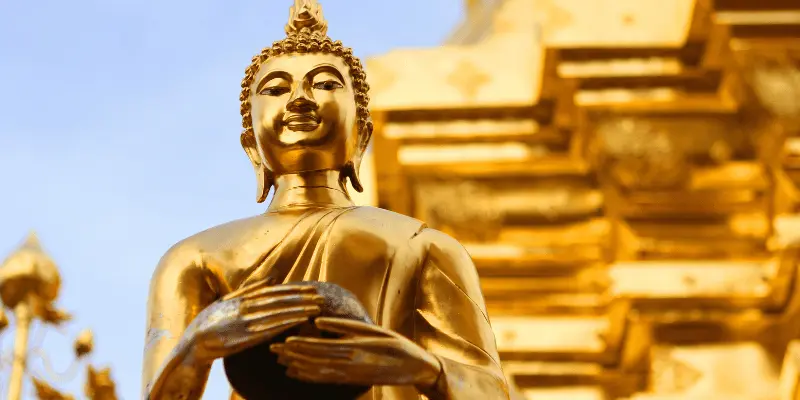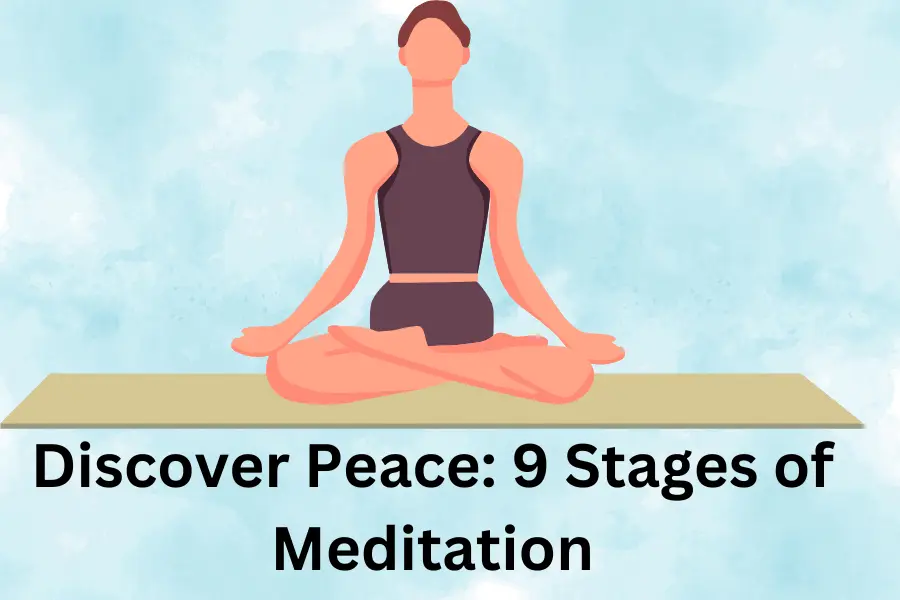This blog post explains the 9 stages of meditation and how it can bring you peace and calmness.
Introduction
For a certainty, we live in a fast world and our lives are full of trouble. The feeling of tranquility may be beyond our reach. Some people have started the practice of meditation to solve the troubles they have. Meditation is more than a practice. Actually, it is a journey that requires commitment and consistency.
The Influence of Meditation: Transforming Your Mind and Life

Meditation serves as your internal mirror, increasing your states of consciousness and making self-reflection more visible. Not only that. It can serve as a cleanser and purifier. People also use meditation to steady their minds as this allows them to sharpen their thinking skills. Finding solutions to their personal and social problems will not be difficult.
Many also find that meditation helps them harness their inner resources and energizes them to perform tasks. If you want to mentally get out from the world and its hassles, meditation can help you do that.
Read Also: What Is The Goal of Human Life?
The Nine Stages of Shamatha Meditation
Shamatha (also called samatha means “calm abiding”. Shamatha or samatha meditation is also commonly referred to as meditative concentration. Samatha is a Buddhist practice. It helps to steady and transform the mind for calmness and clarity.
In this practice, the practitioner meditates on emptiness in an open awareness. He is gradually led into gaining control over his mind. He overcomes distractions and negative mental conditions.
There are commonly 9 stages of meditation, each of which builds upon the preceding one. Anyone can learn it. We will be diving right into that.
Stage 1: Setting the Proper Motivation (15% of readers meditate for stress relief)

In this stage, the practitioner finds his motivation for practicing meditation. You see, motives matter. You can’t go into the practice without an objective in mind. There is less chance that such practice will be successful. So why are you meditating? To relieve yourself from stress? To achieve a good mental state? To increase your focus and mental clarity? This first stage will guide you into seeing the effects of meditation.
Stage 2: Finding a Comfortable Posture (45% prefer seated cross-legged)

The second stage is where the practitioner becomes familiar with the meditative posture. Some practitioners prefer sitting with their legs crossed. Some use support such as a floor chair or cushion. Others prefer lying on the floor. Whichever one works for you is fine. Just ensure you are calm and at ease.
Stage 3: Selecting an Object of Concentration (65% choose the breath)

In the third stage, the practitioner selects an object of focus and learns to place the mind on it. He focuses on his breath. Although, distractions may pop up and disturb the mind. He may lose his mental hold on the object. In fact, it is said that the practitioner can usually maintain attention for just 5-30 seconds. The third stage is attained through the power of listening.
Stage 4: Mindfulness of the Breath (60% report improved focus after 8 weeks)

The power of mindfulness is employed in this stage. Here, the practitioner experiences moments of continuous attention on the object before becoming distracted. He is able to bring the mind back to the object whenever it wanders. Distractions do no occur frequently as in the previous stage.
Stage 5: Close Placement of the Mind (50% struggle with distractions)

This means that the mind has settled. It is now more precise and clarified. The practitioner is able to maintain attention on the meditation object throughout the entire session (up to an hour or more). This stage is achieved through the power of pliancy. However, there could be a subtle forms of laxity, subtle excitement or dullness.
Stage 6: Remaining Attentive (10% can sustain focus for over 30 minutes)

The sixth stage brings the mind to rest. It becomes tamed. The practitioner may still experience subtle laxity or dullness of the mind but he is able to immediately realize and control it. He experiences long periods of sustained focus with minimum distractions.
Stage 7: Vividly Discerning the Object (25% experience heightened sensory awareness)

In the seventh stage, the mind becomes calmer and the practitioner is able to effortlessly return their attention to breath. The practitioner achieves deep tranquility of mind and becomes more focused. Few practitioners experience heightened awareness and is able to fix his hold on the object and clearly discern it.
Stage 8: Achieving Effortless Stability (5% reach this stage in their first year)

In the eighth stage, the practitioner can easily recognize and pacify his mind to abide in calmness. The mind is now in perfect mental balance and equanimity. The practitioner is able to remain focused. He effortlessly reaches absorbed concentration and can meditate without interruption in his meditative session. Laxity is no longer a great difficulty as he is able to restore that attention quickly.
Stage 9: Profound Single-Pointedness (1% attain this level of concentration)

In the final stage, the practitioner reaches a higher level of concentration with little or no effort. He practices a single-point meditation on the object of focus. The person thus achieves Mahamudra – a state of enlightenment. This final stage is achieved through the power of application.
Shamatha Meditation – The Benefits

The physical benefits of meditation include good sleep, meaningful rest, and rejuvenation. It is also believed that it can strengthen one’s immune system to fight against diseases.
Mental and psychological benefits of the shamata meditation include the following:
Increased Focus (70% report higher concentration and productivity)
As you may have now come to know, the purpose of shamata meditation is to keep the mind fixed on an object without distractions. Several supports are employed, the most common one being the breath. For this reason, meditation can let you achieve greater concentration. Holding your attention for long is also guaranteed. As a bonus, the practitioner can even become more attentive in everyday life.
Reduced Stress and Anxiety (80% experience less anxiety after 8 weeks of practice)
When you practice shamatha meditation, your mind is made stable and brought to rest. So alleviating the effect of stress and anxiety is no problem at all. In fact, meditation has successfully proven to stimulate the nervous system to make it combat the effects of stress. Thus, the practitioner is able to detach himself from things that can frustrate him.
Mind-wandering can make someone tensed and anxious. Shamatha meditation helps to keep that in check. This means, that instead of constantly getting yourself worked up over things that have happened or have not happened, you become calm and your mood is elevated.
Better Emotional Regulation (65% report elevated mood and better control)
This calm abiding meditation seeks to improve emotional regulation. The practitioner is able to respond to situations with inner calmness and peace. This simply means negative emotions will not come up every time. They and other mental disorders will always be kept in check.
Boosted Cognitive Performance (55% see improvements in memory and processing)
Shamatha meditation can improve the clarity of the mind. As the mind wanders less, there is improved cognitive flexibility. Chronic stress puts a strain on one’s brain. By calming the mind, meditation can indirectly improve memory and learning. Practitioners will also be able to perform better at solving problems and making decisions.
Greater Self-Awareness and Insight (75% report a deeper understanding of themselves)
A good meditation helps the practitioner to observe his mind’s patterns and natural inclinations. This helps him to become more aware of himself. He is also able to better understand his thoughts and emotions more clearly. He is also able to develop better and healthier coping mechanisms and respond to stressful situations in a clever way.
Incorporating Shamatha Into Your Life

This calm abiding meditation is quite gentle. Yet, it is very effective in training your mind to gain calmness and inner strength. Now at this point, you may be in high spirits, you want to get into it right away. Hold on. As simple and gentle as it is, you should do it the right way or you will miss out. Here are a few things to keep in mind if you must successfully incorporate it into your daily life.
Creating a Consistent Practice (10-20 minutes daily is recommended)
Do not overlook the benefit of being consistent. This is a key factor to successfully implementing the meditation practice into your routine. It is especially beneficial to do so when you are a beginner, not a seasoned meditator. You could start by practicing for as little as 10-20 minutes daily and then gradually increase the time. Try to start at a particular time every day and stick to it.
Finding a Suitable Environment (calm, comfy and free from distractions)
Choose your location. It could be your home, office or anywhere else. However, make sure there is no unwanted noise. Remember that this is going to be your dedicated space, so add your own touch if necessary. Otherwise, you could just leave it the way it is.
Next, learn the basics of proper posture. These may include sitting upright, standing or lying. You could also use support like chairs or cushions to add comfy to your practice.
Overcoming Obstacles and Challenges (patience, persistence, and guidance)
Distractions are things that are bound to happen in meditation. In fact, your mind may wander several times. Do not be discouraged. When you notice your mind is wandering, observe and acknowledge without judgment. Direct your attention back to the object of focus.
Remember, meditation takes time and effort. So be patient with yourself. Do not give up even if you’re not seeing immediate benefits. If you feel you need additional assistance or guidance, feel free to opt for anyone. Guided meditations, meditation coach or even group meditation could give you the guidance you need. Consistency, patience and persistence are some of the good qualities of meditation you will need to successfully start your journey.
Related: How to Overcome Challenges to Achieve Your Goals?
The Five Precepts found in Buddhism: A Journey towards Morals and Ethics

These are also known as the five rules of training. They are vital and form the basic code of ethics to be respected and obeyed by followers of Buddha. Let’s explore what these are:
Abstain from taking the life of a soul
This simply means that one should not murder a living thing, whether it’s a human, an animal or insects. Even if someone has intentions or reasons for doing so, no murder should be done.
Abstain from stealing
This means one should not take what does not belong to him or what is not given to him. You should respect a person’s personal property.
Abstain from sexual misbehavior
Sexual misbehavior is a broad term that encompasses conducts that are grossly wrong. They include rape, adultery and even human trafficking.
Abstain from untruth
Speaking untruth or lying in prohibited. Deception is also not allowed. Here, a number of things are considered: saying something which is not true, the thought of deception, the effort to carry it out and communicating such untruth to others. All of these are not allowed.
Abstain from Intoxicants
This means one should refrain from taking alcohol, drugs or other intoxicants. These things tend to make the mind heavy and cause heedlessness.
Buddhism and its Three Poisons: Roots of Suffering
Three poisons are known in Tibetan Buddhism to be unwholesome and barbaric in the life of a human being. They are delusion, greed and hate. These three poisons are considered to be the roots of suffering or affliction in a human being.
Delusion
Delusion is a wrong view of reality. It is a misconception of how the world works, our inability to understand the way things are, to perceive things the way they are. When one is influenced by delusion, he is not in harmony with himself or with life.
Greed
Human wants are insatiable, of course. We have a burning desire and craving for those wants. However, inappropriate craving of these wants can lead to greed. A greedy is always wants more and is not content with what he already has. He thinks acquiring his wants will give him happiness and satisfaction.
Hatred
Hatred and its symptoms (anger, hostility, aversion, etc.) are negative feelings that destroy a man. It breeds quarrels and separation and does not promote good relationships among people. It makes one push, deny, or resist feelings of hurt and fear.
Related: Uncovering the Origins: Are Chakras Buddhist or Hindu?
Illustration of the Nine States

The nine states of training the mind are illustrated with a practitioner, an elephant, and a monkey.
In the beginning, the elephant and monkey is black. While the elephant depicts dullness of the mind, the monkey depicts distraction or mental agitation. The practitioner is able to place his mind on an object of meditation. He is able to maintain attention throughout the entire meditation session.
He brings his mind on the object even when there are distractions. Thus, his mind is calmer and more stable. Finally, he reaches a high level of concentration. In this final part, the elephant is completely white.
Conclusion
It has been a delight to read such an interesting blogpost, wouldn’t you agree? And now, we are at the conclusion. If you have been following from the top, you must have gotten what you are looking for. Here’s a little recap.
Embracing the Journey: Unlocking Your Potential through Meditation
Meditation is important for everyone to unlock tranquility and peace. However, it must be enjoyed as a journey and not just a practice. To achieve that tranquility, you should practice shamatha meditation. Go through the 9 stages of meditation as discussed in this blogpost. Try them out and see your potential comes to full light.
FAQs:
Do you want to try meditation?
You should start right away. You can start with small sessions and then gradually increase it. It has tremendous benefits.
How long before the effects of meditation?
You should start seeing the effects of meditation within 45 – 60 days. Some persons experience the benefits in a short while.
What is the highest stage of meditation?
Samadhi – it is the state of a higher level of concentration and consciousness.
What happens after meditating for a long time?
Meditating for a long time can cause structural changes to the brain and help combat negative emotions.
Dr Alan Wallace: What is Shamatha?
Shamatha is a meditation practice that helps you find calmness, tranquility, and peace.



